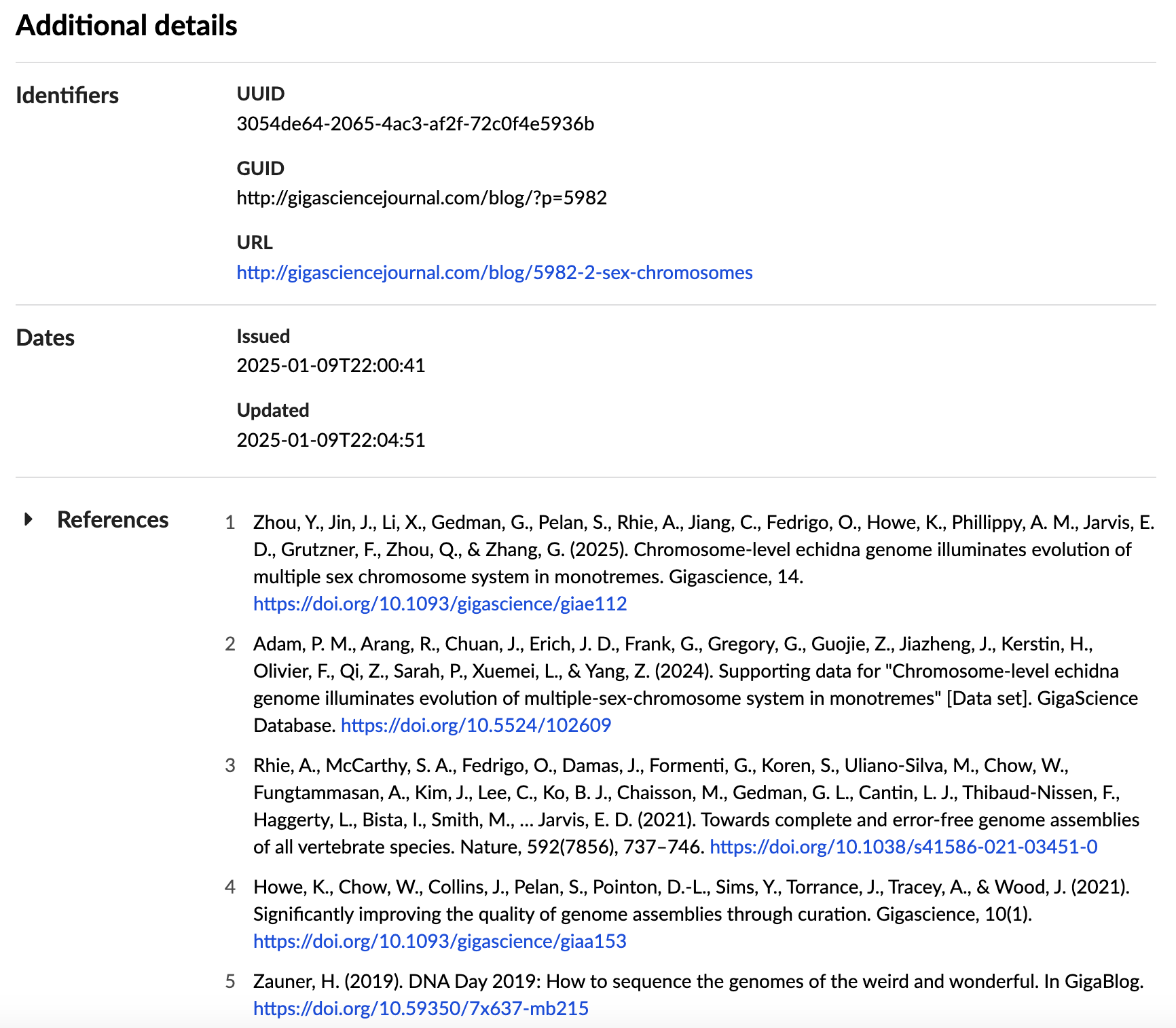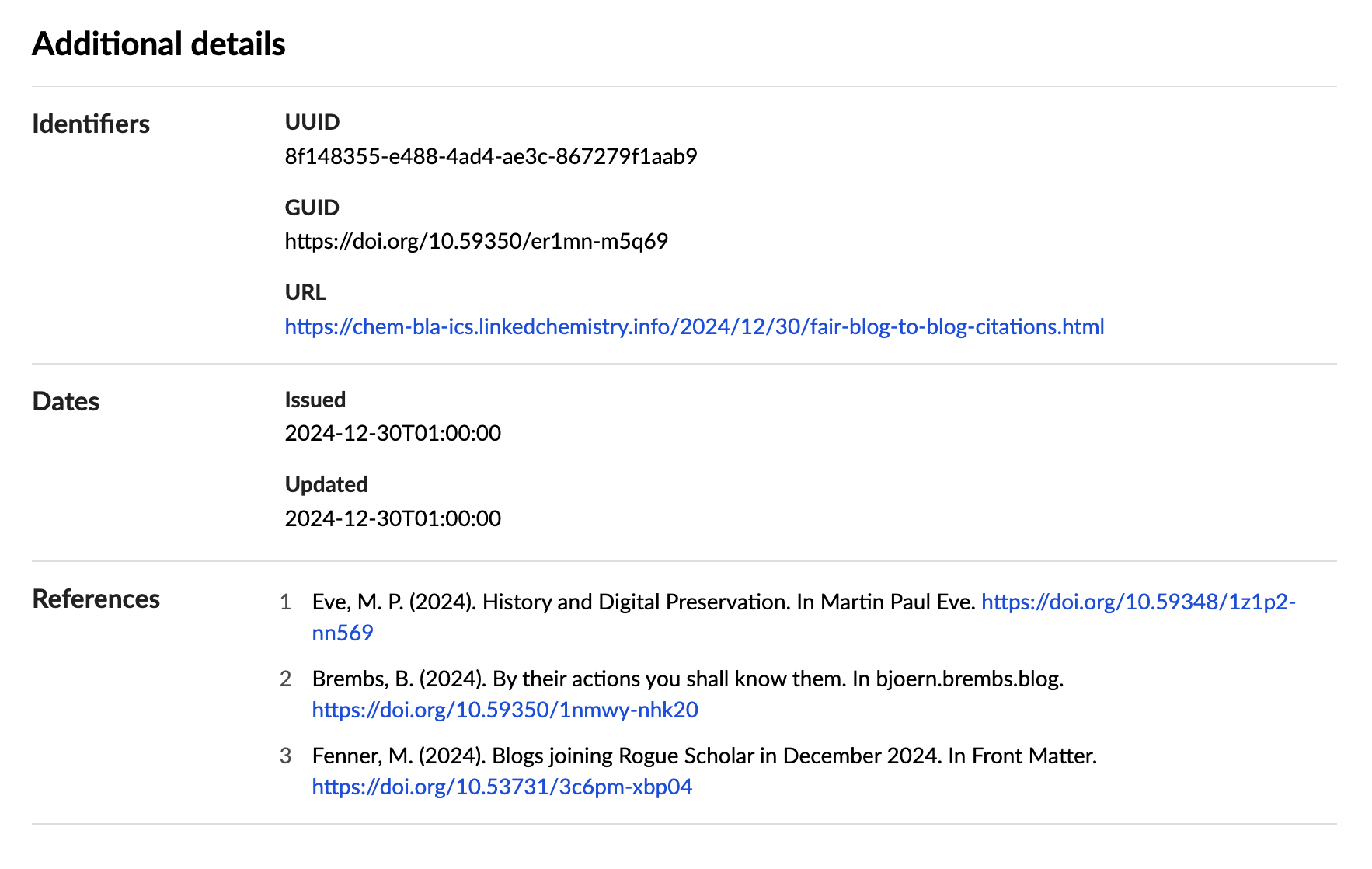References are an essential element of scholarly publications. This week the Rogue Scholar science blog archive has improved the display of the references of the blog posts it archives, showing them in the APA citation style if they use a DOI:

This of course also works for references of Rogue Scholar blog posts:

While formal references in science blog posts are not as common as in some other content types, Rogue Scholar has archived 896 blog posts with references as of today, and some of them include more than 30 references:

The APA style is not only one of the most widely used and documented citation styles, but it also correctly shows DOIs, following the Crossref DOI Display Guidelines:
When displaying DOIs, it’s important to follow these display guidelines. Crossref DOIs should:
- always be displayed as a full URL link in the form https://doi.org/10.xx
- not be preceded by doi: or DOI:
- not use dx in the domain name part of DOI links
- and we recommend HTTPS (rather than HTTP).
The APA style also supports many different content types, including specific formatting for datasets and software (which require a version number and content type):

One could argue that the critical element in a reference is the (machine-readable) DOI or other persistent identifier. Still, the formatted reference string provides important information to the human reader for scanning reference lists.
What is left to do for Rogue Scholar is properly format references in APA style that cite web resources with a URL. This is much more difficult to automate, as even basic metadata such as title, author, and publication date are more difficult to retrieve or don't exist. The commonmeta-py Python library that I currently use to fetch and format DOI metadata has basic support for retrieving schema.org and HTML meta tag metadata embedded into web pages, but more work is needed. The basic assumption is that generating references for blog authors should be easy and requires only a list of DOIs or URLs in a section called References at the end of a blog post.
Another question is the persistence of URL references. If I read a scholarly blog post five or ten years after publication, I not only hope the blog post is still available – a major reason I launched the Rogue Scholar science blog archive – but that the most important references are also still available, with content at least similar to what the blog post author was referencing – the never-ending topic of link rot and content drift.
Finally, there is more work needed to make it easy for blog authors to include scholarly references. Very few blogging platforms provide this functionality natively or via an extension.
I hope that the improved display of references in the Rogue Scholar platform announced today encourages blog authors to include formal references in their posts.
References
- Zauner, H. (2025, January 9). Sex chromosome madness in the iconic echidna. GigaBlog. https://doi.org/10.59350/9509z-ns663
- Willighagen, E. (2024, December 30). FAIR blog-to-blog citations. Chem-Bla-Ics. https://doi.org/10.59350/er1mn-m5q69
- Marcum, C. S. (2024, August 27). Drinking from the Firehose? Write More and Publish Less. Upstream. https://doi.org/10.54900/r8zwg-62003
- Fenner, M. (2024, February 20). Commonmeta-py now supports metadata lists. Front Matter. https://doi.org/10.53731/b8j4w-zpk40
- Fenner, M. (2024). Commonmeta-py (Version 013.2) [Computer software]. Zenodo. https://doi.org/10.5281/zenodo.10615902
- Klein, M., Van De Sompel, H., Sanderson, R., Shankar, H., Balakireva, L., Zhou, K., & Tobin, R. (2014). Scholarly Context Not Found: One in Five Articles Suffers from Reference Rot. PLoS ONE, 9(12), e115253. https://doi.org/10.1371/journal.pone.0115253


